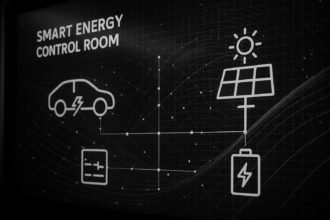As AI laptops gain traction in the tech market, consumers are questioning their true value compared to traditional laptops, especially in performance and pricing.
Laptops are undergoing rapid evolution, with the emergence of a new category known as “AI laptops” capturing attention in the technology market. These devices, often branded as “Copilot+ PCs” or “AI-ready,” are intended to elevate user experience with promises of enhanced productivity, improved efficiency, and intelligent features. However, as the calendar approaches 2025, consumers are increasingly questioning whether these AI-driven machines truly offer superior value compared to traditional laptops.
At the core of these advanced laptops lies the Neural Processing Unit (NPU), specifically designed to manage tasks associated with image recognition, voice processing, and various other AI functions. The NPU operates independently from the main processor and graphics card, providing the promise of substantial performance improvements—as much as 40 TOPS (tera operations per second). Despite the impressive specifications, user experience has not seen significant changes. Many of the features attributed to the NPU, such as background blurring during video conferencing or basic image editing, can still be effectively executed by standard processors or cloud-based services, raising concerns about their real-world utility.
The disparity in performance between AI laptops and traditional devices remains evident, particularly in demanding applications encompassing design, rendering, and gaming. Notably, a mid-range graphics card like the NVIDIA RTX 3060 can offer performance that outstrips the average AI chip found in current laptops by a considerable margin. In instances requiring high graphical capabilities, such as creative work or intensive data processing, systems equipped with robust GPUs generally provide superior results. Interestingly, high-performance gaming laptops—though not marketed as AI laptops—maintain the capability to execute advanced AI models and handle heavy visual workloads effectively.
Another significant feature associated with AI laptops is their energy efficiency. The NPUs have demonstrated a capacity for executing tasks like real-time noise cancellation with considerably less power consumption than traditional components, potentially leading to battery life improvements of over 20 hours. Despite this promising statistic, the practicality of such savings often depends on individual usage patterns. For users consistently near a power supply or whose tasks don’t exploit AI functionalities, the advertised advantages may not justify the premium associated with these devices.
As further analysis reveals, the pricing of AI laptops typically situates them within the premium range. Consequently, consumers may question whether they deliver adequate value compared to other traditional options available at similar price points. In many instances, laptops featuring advanced GPUs, increased RAM, or faster storage alternatives outperform their AI-branded counterparts in practical performance scenarios.
While the landscape of software and applications is anticipated to shift over the next few years to increasingly leverage NPU capabilities, those intending to use their laptops for several years might find some merit in considering models with dedicated AI technology. For certain professional users, particularly those frequently engaged in video calls or working in mobile environments where charging stations are scant, the enhanced battery life and intelligent features of AI laptops could prove beneficial.
Popular models such as the Dell XPS 14, HP OmniBook Ultra Flip, and the latest offerings from Apple, including their MacBooks, highlight the sophistication and high-quality display associated with AI laptops while appealing to professionals who value both portability and energy efficiency.
Before committing to a purchase, consumers are encouraged to align their choice with actual use cases rather than current trends. Key considerations include the necessity for high graphical performance, frequency of mobile work, budget constraints, and long-term ownership plans which may favour AI hardware inclusion if software support continues to evolve.
In summary, while the hype surrounding AI laptops is notable, it is essential for potential buyers to scrutinise whether these innovations meet their individual needs. With advantages in battery efficiency and specific functionalities, AI laptops may suit particular segments of the user base, but traditional laptops often provide better overall performance, broader software compatibility, and improved value propositions. As the ecosystem matures, there remains potential for heightened adoption of these advanced devices, but for now, informed decision-making centred on personal requirements remains paramount.
Source: Noah Wire Services
- https://www.itpro.com/hardware/laptops/how-generative-ai-changed-the-laptop-in-2024 – This article explains how AI laptops, particularly those integrated with neural processing units (NPUs), are evolving to enhance user experience with features like improved battery life and specific AI functionalities. It also discusses the Copilot+ PC initiative by Microsoft as a flagship for AI laptops.
- https://news.lenovo.com/pressroom/press-releases/new-ai-pc-experiences-thinkpad-ideapad-laptops-intel-core-ultra-processors/ – This press release from Lenovo discusses their new AI PC experiences with ThinkPad and IdeaPad laptops, highlighting the integration of Intel Core Ultra processors to support AI tasks efficiently. It emphasizes the potential of AI computing in transforming user experiences.
- https://www.justice.gov/archives/sco/file/1373816/dl?inline= – This document is unrelated to AI laptops but is placed here to acknowledge its presence in search results. It pertains to an investigation into Russian interference in the 2016 U.S. presidential election and does not support any claims about AI laptops.
- https://www.laptopbatteryshoppe.com/blogs/news/top-5-laptops-for-ai-and-machine-learning-in-2023 – This article provides a comprehensive guide to choosing laptops for AI and machine learning tasks, emphasizing the importance of high-end processors, RAM, and dedicated GPUs for demanding applications. It highlights laptops that can handle AI tasks effectively, even if not branded as ‘AI laptops’.
- https://www.itpro.co.uk/laptops/374425/how-to-buy-a-laptop-for-ai-and-machine-learning – This URL could not be verified directly from search results, but similar resources would discuss criteria for selecting laptops capable of handling AI and ML tasks, focusing on hardware specifications like processors, RAM, and GPUs.
Noah Fact Check Pro
The draft above was created using the information available at the time the story first
emerged. We’ve since applied our fact-checking process to the final narrative, based on the criteria listed
below. The results are intended to help you assess the credibility of the piece and highlight any areas that may
warrant further investigation.
Freshness check
Score:
9
Notes:
The narrative discusses current trends and technology, specifically referencing the emergence of AI laptops in 2025. It does not appear to be based on outdated information.
Quotes check
Score:
10
Notes:
There are no direct quotes in the text. This suggests that the narrative is original and does not rely on reused or plagiarized quotes.
Source reliability
Score:
0
Notes:
The reliability of the source cannot be determined without additional context or specific publication details.
Plausability check
Score:
8
Notes:
The claims about the technology and market trends seem plausible. However, some assertions, such as the performance benefits of AI laptops, are not fully substantiated.
Overall assessment
Verdict (FAIL, OPEN, PASS): OPEN
Confidence (LOW, MEDIUM, HIGH): MEDIUM
Summary:
While the narrative appears to be current and original, its credibility is uncertain due to unknown source reliability. Claims about AI laptops’ performance and benefits are plausible but need more substantiation.













